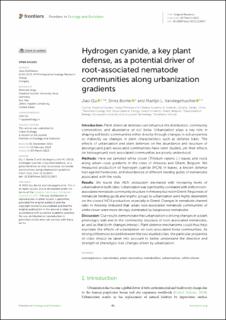| dc.contributor.author | Qu, Jiao | |
| dc.contributor.author | Bonte, Dries | |
| dc.contributor.author | Vandegehuchte, Martijn Lodewijk | |
| dc.date.accessioned | 2023-10-24T09:17:32Z | |
| dc.date.available | 2023-10-24T09:17:32Z | |
| dc.date.created | 2023-03-31T13:00:33Z | |
| dc.date.issued | 2023 | |
| dc.identifier.citation | Frontiers in Ecology and Evolution. 2023, 11 . | en_US |
| dc.identifier.issn | 2296-701X | |
| dc.identifier.uri | https://hdl.handle.net/11250/3098297 | |
| dc.description.abstract | Introduction: Plant chemical defenses can influence the distribution, community composition, and abundance of soil biota. Urbanization plays a key role in shaping soil biotic communities either directly through changes in soil properties or indirectly via changes in plant characteristics such as defense traits. The effects of urbanization and plant defenses on the abundance and structure of aboveground plant-associated communities have been studied, yet their effects on belowground root-associated communities are poorly understood.
Methods: Here we sampled white clover (Trifolium repens L.) leaves and roots along urban–rural gradients in the cities of Antwerp and Ghent, Belgium. We measured production of hydrogen cyanide (HCN) in leaves, a known defense trait against herbivores, and abundances of different feeding guilds of nematodes associated with the roots.
Results: We found that HCN production decreased with increasing levels of urbanization in both cities. Urbanization was significantly correlated with shifts in root-associated nematode community structure in Antwerp but not in Ghent. Responses of nematode feeding guilds and trophic groups to urbanization were highly dependent on the clovers’ HCN production, especially in Ghent. Changes in nematode channel ratio in Antwerp indicated that urban root-associated nematode communities of white clover were more strongly dominated by fungivorous nematodes.
Discussion: Our results demonstrate that urbanization is driving changes in a plant phenotypic trait and in the community structure of root-associated nematodes, as well as that both changes interact. Plant defense mechanisms could thus help elucidate the effects of urbanization on root-associated biota communities. As strong differences existed between the two studied cities, the particular properties of cities should be taken into account to better understand the direction and strength of phenotypic trait changes driven by urbanization. | en_US |
| dc.language.iso | eng | en_US |
| dc.publisher | Frontiers Media S. A. | en_US |
| dc.rights | Navngivelse 4.0 Internasjonal | * |
| dc.rights.uri | http://creativecommons.org/licenses/by/4.0/deed.no | * |
| dc.title | Hydrogen cyanide, a key plant defense, as a potential driver of root-associated nematode communities along urbanization gradients | en_US |
| dc.title.alternative | Hydrogen cyanide, a key plant defense, as a potential driver of root-associated nematode communities along urbanization gradients | en_US |
| dc.type | Peer reviewed | en_US |
| dc.type | Journal article | en_US |
| dc.description.version | publishedVersion | en_US |
| dc.source.volume | 11 | en_US |
| dc.source.journal | Frontiers in Ecology and Evolution | en_US |
| dc.identifier.doi | 10.3389/fevo.2023.1113671 | |
| dc.identifier.cristin | 2138864 | |
| cristin.ispublished | true | |
| cristin.fulltext | original | |
| cristin.qualitycode | 1 | |

